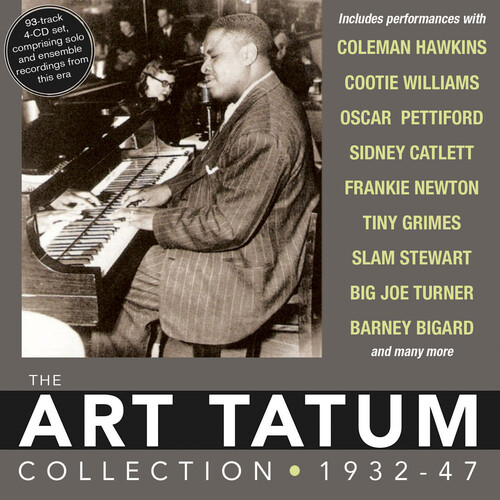 If you’re going to learn about jazz piano, there are a handful of essential musicians that you simply have to associate yourself with. Here’s the list: Earl Hines, Art Tatum, Teddy Wilson, Bud Powell, Horace Silver, Herbie Hancock and McCoy Tyner. That’s about it.
If you’re going to learn about jazz piano, there are a handful of essential musicians that you simply have to associate yourself with. Here’s the list: Earl Hines, Art Tatum, Teddy Wilson, Bud Powell, Horace Silver, Herbie Hancock and McCoy Tyner. That’s about it.
So, here in this 4 disc 93 track set is the world of piano that even brought classical artists such as Toscanini and Rubenstein into dingy clubs in order to hear majestic solo performances by this half blind guy with bananas for fingers. This anthology takes you into the inspirational collection of his earliest sessions as a eye dropping soloist and torrid small group member, both in leader and sideman, just before he went “big time” with Capitol, signing up with Norman Granz. This songs are culled from various labels as well as war-time V Discs.
The music itself is simply earth shaking, at times Tatum sounds like two pianists at once such as on 1933’s hand-is-quicker-than-the-ear “Tiger Rag” and “Tea For Two”. In solo format, his music can almost be described as baroque, with wonderfully flowery interpretations of “Liza”, “Star Dust” and “Humoresque”. His 1940 interpretation of “Cocktails For Two” “Sophisticated Lady” and “Get Happy” are simply overwhelming, causing countless aspiring pianists to change career directions and become insurance salesmen.
This collection also has him in some small group formats with singers like Joe Turner, usually delving into the blues as on “Rock Me Mama” and “Corrine Corrine” when a leader, or teaming up with Ellingtonian Barney Bigard for some traditional material like “Blues For Art’s Sake”. He does lead his own trio, and if it were any other pianist, you’d be impressed by his takes of “Soft Winds”, “I Know That You Know” and “I Got Rhythm”. But this is Art Tatum, and he always sounds a bit restricted when held down with the bit of other jazz artists. The only exception is with an all-star group that included fellow virtuoso Coleman Hawkins, with Tatum sounding quite inspired. Otherwise, this was a man who was created to be unencumbered.
Tatum was a musician and artist born and bred on stride, so his approach is always full fisted, and even when you think he’s going off time, if you have a metronome, you will find out that it is you, the listener, who has the problem with tempo. If you’ve only been exposed to the modern ivories of jazz, this set will steer you into a style that is glorious, beautiful, bluesy, inspiring and above all, relentlessly swinging.
There is a reason that Randy Weston would play Art Tatum albums every day of his life, and Muhal Abrams used a Tatum solo piece for his phone answering recording. Tatum was part of the Mount Rushmore of the ivories. The Paganini and Liszt of jazz.